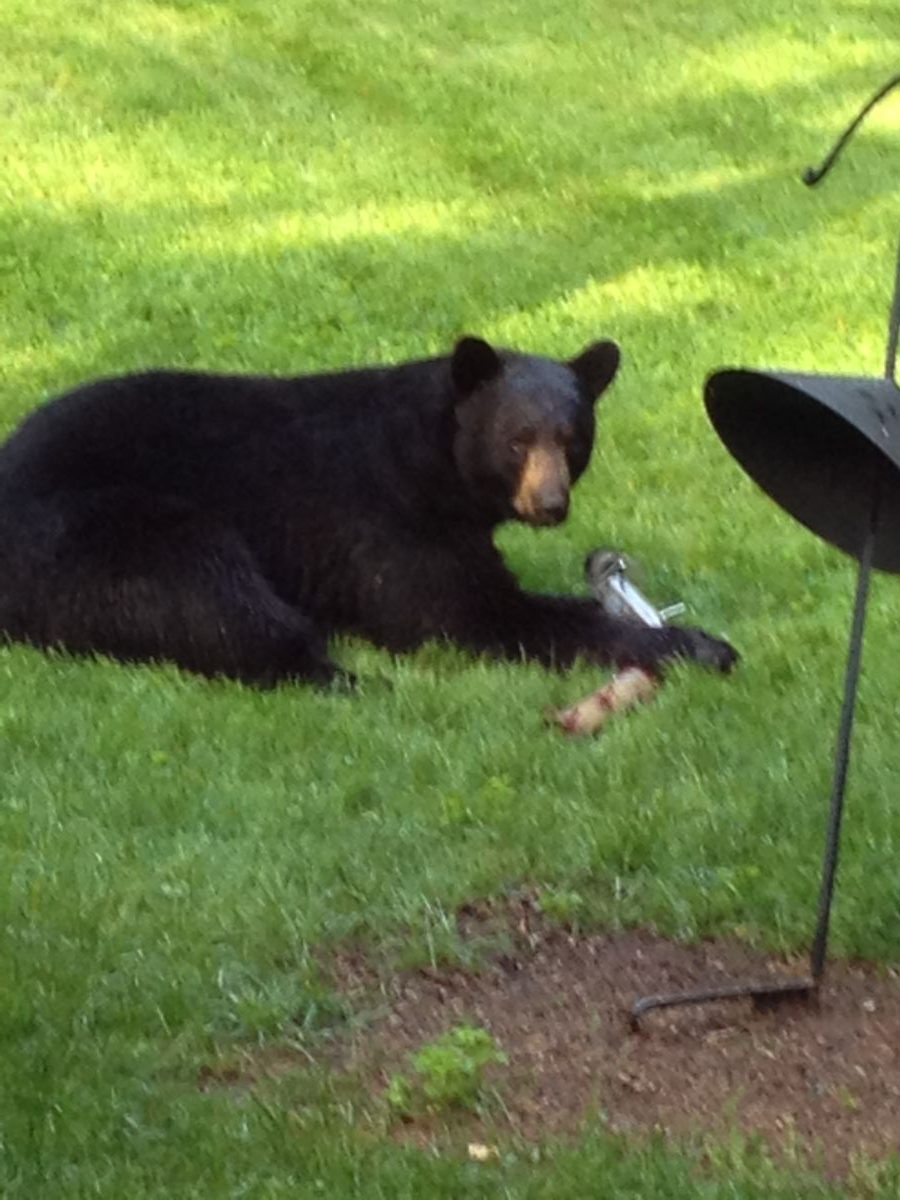Another bird feeder, that is.
We live on the edges of a state park. So once the weather warms up, we remind ourselves every day to bring in the bird feeder at twilight. Inevitably, there comes an evening when we forget. We hear something clanking in the yard, and look outside, and guess what—there’s a bear mooching around the back yard. It’s already yanked the metal post to the ground and unhooked the bird feeder. Now it’s licking up all the bird seed, looking like a large-scale Winne the Pooh scooping that last bit of honey out of the jar.
A couple of years ago, we switched from nuts-and-berries birdseed, which was great for attracting songbirds but got the feeder dragged deep into the woods–twice. Now we use sunflower seeds, a less aromatic and enticing food for bears, and at least the feeder tends to survive.
When we spot a bear, we grab pots and pans, then bang them with a metal spatula until the bear rises and ambles off behind a tree or the garage. He never goes very far and will sometimes peek out like a dog who’s been scolded but wants to be forgiven.

Still banging the pots, we dash out to grab the feeders and bring them inside. Then we lock the door behind us. (A few years ago in a neighboring town, a bear crashed through a screen door. He was after the peanut butter on the counter, but apparently he checked out the refrigerator as long as he was there.)
Unlike the coyote population, which has been stable at 10,000 for many years, the bear population is on the rise in Massachusetts. There are about 4,500 now, with the number rising every year and the range extending farther and farther eastward. In my town of Amherst, bears now cross busy roads and amble their way through people’s yards. Last week, one was photographed on the roof of a home in a downtown neighborhood. I’m sure some people consider them nuisances.

But I enjoy living on the edge of the forest. We’ve seen coyotes, foxes, and deer step quietly across the lawn. We’ve heard owls and hawks and bands of turkeys (usually about three females and ten chicks, with the chicks making soft cheeping sounds as they hop along). Bears are part of the fun. I’d feel differently about grizzlies—they’re larger, and quite a bit more aggressive—but our local black bears look like Newfoundland dogs, with sweet brown muzzles and soft brown eyes. They attack only when humans get between them and their cubs. (Well, maybe if we get between them and a food source, too–though I’ve never heard of it.) A barking dog will usually send them scurrying up a tree for safety. In fact, back when we had a timid Portuguese Water Dog, I once let her out into the back yard without looking first. (That’s a mistake one makes only once.) She ran out, stopped dead when she smelled that the large, furry thing at the feeder was not one of her dog-friends, and then lit out for the woods. I suspect she ran all the way up the hill to the neighbors’ house and took shelter there. But she appeared at the back door an hour later, tail wagging, seeming to have forgotten all about that big, scary bear. (He’d barely seemed to notice her.)
Yesterday we decided that we will hang the bird feeder out only when we’re sitting out on the back terrace. We’ll take it when we’re done with our lunch or cocktails. But what do you think the odds are that we’ll forget some evening–and that we’ll get another large, shy, awkward visitor? About 100%?
Me, too….

My neighbor just got baby chickens. The neighborhood hawks are soaring overhead daily. Yesterday two of them, each about a foot tall, rested on a dead tree limb in my yard. Their wing span is huge! Gorgeous!
I warned my neighbor….
I hope your neighbor has a roof over the yard for the chickens. Otherwise, some of those chicks are definitely going to bite the dust!
Those hawks, probably red-tails but occasionally red-shouldered hawks, Thoreau appropriately called “chicken hawks”. He tried to get his neighbors to let them be, without much success.
Wow, that is certainly something we’d never see around here! I love that you live so close to wildlife and have learned (for the most part 🙂 ) to adjust. As we take over more and more of their land, we need to realize that we are the interlopers, not them. I love the picture of the bear peering around the tree.
Hey Nancy! I’m with Janis in saying you’d NEVER see one of those in your yard where we live. On a very rare occasion you might see a coyote but we live a bit far from the mountains now and that doesn’t happen often. Instead we do see roadrunners and LOTS of other birds including humming birds, doves and quail. Oh, and we must not forget lizards! We live on a small lot in town but we put in natural desert landscaping and the local creatures seem to welcome a spot that seems far more natural than another home with a grass yard. I think it has become so easy for us all to forget that the local creatures have as much right to be here as we do so good for you for just learning to co-exist with them and enjoy their presence. ~Kathy
Our coyotes are different from yours, too. The eastern coyotes mated with wolves as they migrated east through the Canadian Rockies, and they’re larger and look like a big German shepherd dog (but wilder). But how nice that we have lots of birds and lizards in your yard!